Kate brought us in closer to consider the importance of the tools’ accessibility and their effect on learning. Not only do these tools need to be accessible to the students, but students need to understand how and when to use them for learning.
![]()
Viewing: Blog Posts Tagged with: Charts, Most Recent at Top [Help]
Results 1 - 25 of 56
Blog: TWO WRITING TEACHERS (Login to Add to MyJacketFlap)
JacketFlap tags: Kate Roberts, Maggie Beattie Roberts, DIY Literacy, writing workshop, charts, academic choice, Add a tag
Blog: TWO WRITING TEACHERS (Login to Add to MyJacketFlap)
JacketFlap tags: writing workshop, charts, back to school, first day, Add a tag
You can learn a lot about students when you give them a chance to tell you want they know!![]()
Blog: TWO WRITING TEACHERS (Login to Add to MyJacketFlap)
JacketFlap tags: poetry, mentor texts, writing workshop, charts, Add a tag
My last post was about some of the reflections that I want to remember when I teach any genre of writing, but I also wanted to share more of our poetry workshop and… Continue reading ![]()
Blog: TWO WRITING TEACHERS (Login to Add to MyJacketFlap)
JacketFlap tags: writing process, writing workshop, charts, scaffolding charts, writing workshop routines, Add a tag
My sixth graders have been busy drafting their feature articles this week, and I had a series of mini lessons planned to begin each writing workshop day. My students, however, had other ideas.
![]()
Blog: PW -The Beat (Login to Add to MyJacketFlap)
JacketFlap tags: World Comics, Sales, Sales Charts, Charts, Add a tag
Federico Salvan of the Italian comics news site Manga Forever dropped me a line to alert me to a retailer survey on the state of Italian comics . It’s in Italian, of course, but they surveyed 31 local comics shops out of about 180 in Italy, so it’s a somewhat statistically significant survey. I’ve asked […]
Blog: TWO WRITING TEACHERS (Login to Add to MyJacketFlap)
JacketFlap tags: writing workshop, primary grades, charts, dialgoue, Add a tag
Blog: OUPblog (Login to Add to MyJacketFlap)
JacketFlap tags: exchange rates, 2016, interest rates, energy markets, economic trends, economic statistics, brexit, oil prices, monetary policies, oil market, Books, charts, economy, US Elections, inflation, euro, david cameron, *Featured, Business & Economics, US economy, Federal Reserve, European Central Bank, Economic Policy with Richard S. Grossman, unemployment data, Add a tag
Economists are better at history than forecasting. This explains why financial journalists sound remarkably intelligent explaining yesterday’s stock market activity and, well, less so when predicting tomorrow’s market movements. And why I concentrate on economic and financial history. Since 2015 is now in the history books, this is a good time to summarize a few main economic trends of the preceding year.
The post Economic trends of 2015 appeared first on OUPblog.
Blog: TWO WRITING TEACHERS (Login to Add to MyJacketFlap)
JacketFlap tags: charts, Add a tag
Blog: TWO WRITING TEACHERS (Login to Add to MyJacketFlap)
JacketFlap tags: writing workshop routines, writing workshop, charts, strategy charts, Add a tag
Start the year off right with charts that make expectations, strategies and tips on writing visible for students. ![]()
Blog: TWO WRITING TEACHERS (Login to Add to MyJacketFlap)
JacketFlap tags: writing workshop, primary grades, charts, Add a tag
Blog: TWO WRITING TEACHERS (Login to Add to MyJacketFlap)
JacketFlap tags: authors, classroom, writing workshop, charts, tcrwp, strategy charts, anchor chart, SmartBoard, Kristi Mraz, Marjorie Martinelli, Chartchums, Smarter Charts, Add a tag
It's always a joy to learn with Majorie Martinelli and Kristi Mraz. In this interview, they share some excellent advice on using charts to support independence in the classroom.![]()
Blog: TWO WRITING TEACHERS (Login to Add to MyJacketFlap)
JacketFlap tags: middle school, Spanish, guest blogger, French, charts, foreign language, growth mindset, Add a tag
Learn how literacy coach Mindi Rench has helped middle school world language teachers to con-construct charts with their students, which has helped students' writing in French and Spanish.![]()
Blog: OUPblog (Login to Add to MyJacketFlap)
JacketFlap tags: disc, discs, the beatles, hamburg, brian epstein, retailer, Editor's Picks, *Featured, Love Me Do, Arts & Leisure, New Musical Express, Alan Smith, Billy Fury, Decca, Don Arden, Gordon R. Thompson, Melody Maker, North End Music Stores, record charts, Record Retailer, Music, london, charts, Add a tag
By Gordon R. Thompson
The Beatles were unlikely successes on London’s record charts in December 1962. Northerners with schoolboy haircuts who wrote and performed their own songs, their first record “Love Me Do” had risen slowly up British charts, despite lack of significant promotion by their publisher and record company, and without an appearance on national television. Moreover, while they should have been touring Britain to promote the disc, they instead played a pre-booked residence at the Star Club in Hamburg. The disc should have flopped.
Some have speculated that the Beatles’ manager Brian Epstein arranged for the family business, North End Music Stores to purchase enough copies of the record to move it in the charts. “Fiddling” with the charts was hardly unknown both in Britain and in the US. The notorious British manager Don Arden (Sharon Osborne’s father) later bragged that he could move the rank of a disc with a discrete monetary investments.
The most widely read music papers of the day — the weeklies The New Musical Express and Melody Maker — contained interviews with artists, managers, producers, and songwriters, listed tour dates and contract changes, featured recently released discs in reviews, and ranked the week’s top recordings. By today’s standards, their methods were primitive, blending a few calls to big merchants with personal intuition. An informed manager or producer could move a release in the charts simply by purchasing the right number of discs in the right shops or by persuading the right people that particular artists were the next big thing.
Click here to view the embedded video.
The curious chart history of “Love Me Do” sees the song appear first on Record Retailer’s charts shortly after its release and then two weeks later on Melody Maker’s charts. In Record Retailer, the disk would reach #17 in the 27 December 1962 issue, while in Melody Maker, it reached #21 the first week of January. The recording entered the charts of Disc weeks after the other papers and climbed no higher than #24 in December.
If these charts represent record sales, one wonders why they should differ. Record Retailer prided itself on having its finger on the pulse of record merchandising by polling its readership: Britain’s retail disc merchants. Earlier in 1962, when a flu swept through Decca’s manufacturing plant disrupting their ability to press records, both Melody Maker and the Daily Mail published charts showing Elvis Presley’s newest recording (“Rock-a-Hula Baby”) suddenly holding the #20 position, despite the absence of disks to sell. Melody Maker insisted that it had placed the disk in the charts because of comments from retailers combined with a previous announcement of its release. Melody Maker’s stated sources — and their data on record sales — suggest that the venerable music paper relied on selected stores and intuition. Another variable in these numbers recognizes that some figures may reflect the number of discs purchased by shop owners as distinct from the number of disks purchased by customers.
Two weeks after “Love Me Do” entered Record Retailer’s charts, NME apparently gave the recording a quick guess placement, before dispatching it to presumed history. An October 26 article by one of NME’s writers, Alan Smith, extols the group and the budding talent of its songwriters. “Newcomers to the Charts: Liverpool’s Beatles Wrote Their Own Hit” makes the connection between the Beatles and Billy Fury and promoted the potential of the recording. The NME’s editors apparently seized upon the convergence of sales reports in other papers and the press releases to write something they thought would sell a few papers.
Over at Record Retailer, however, the disk climbed slowly with little apparent promotion, peaking at the end of the year, setting the stage for the release of their second single, “Please Please Me,” which the Beatles had already recorded in November. Breaking into the charts represented a remarkable feat for a new group, let alone one from the provincial and industrial north. Perhaps Liverpudlian Billy Fury had paved the way for them with three significant hits in 1962: “Letter Full of Tears” (charts 15 March, UK #32), “Last Night Was Made for Love” (charts 3 May; UK #4), and “Once upon a Dream” (charts 19 July, UK #7).
Click here to view the embedded video.
That cold and dark December would see Ray Davies meet British bluesman Alexis Korner and work his way into Dave Hunt’s Rhythm and Blues Band and play at the Piccadilly Jazz Club. There, another new group, the Rolling Stones (who had just landed a bass player in the form of Bill Wyman) would impress him. Something musical was beginning to happen in London. Something raw and exciting.
Gordon Thompson is Professor of Music at Skidmore College. His book, Please Please Me: Sixties British Pop, Inside Out, offers an insider’s view of the British pop-music recording industry. Check out Gordon Thompson’s posts on The Beatles and other music here.
Subscribe to the OUPblog via email or RSS.
Subscribe to only music articles on the OUPblog via email or RSS.
The post Charting success: The Beatles, December 1962 appeared first on OUPblog.
Blog: TWO WRITING TEACHERS (Login to Add to MyJacketFlap)
JacketFlap tags: paragraphing, conventions, charts, Add a tag
I took your wise words and put them together in a chart. It’s hanging in my office because I love how it is a reminder of the power of collaboration. It also restores… Read More ![]()
Blog: PW -The Beat (Login to Add to MyJacketFlap)
JacketFlap tags: Charts, Sales, Sales Charts, Add a tag
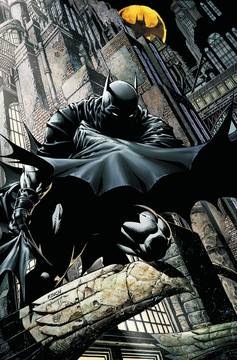
Here are the complete sales charts from Diamond for last month:
Terminology: Indie is a is an Non-Premier publisher, i.e. not Dark Horse, DC, IDW, IMage or Marvel.
Small Press: Diamond Comic Distributors defines Small Presses as publishers outside the top-10 bestselling publishers over the previous six months.
Diamond’s Top 300 Comics: February 2012
Diamond’s Top 300 Graphic Novels: February 2012
Diamond’s Top 50 Manga: February 2012
Diamond Top 50 Indie Comics: February 2012
Diamond’s Top 50 Indie Graphic Novels: February 2012
Diamond’s Top 50 Small Comics: February 2012
Diamond’s Top 50 Small Graphic Novels: February 2012
Diamond’s Top Books, Toys, Games, etc: February 2012
Blog: PW -The Beat (Login to Add to MyJacketFlap)
JacketFlap tags: Sales, Sales Charts, Charts, Add a tag
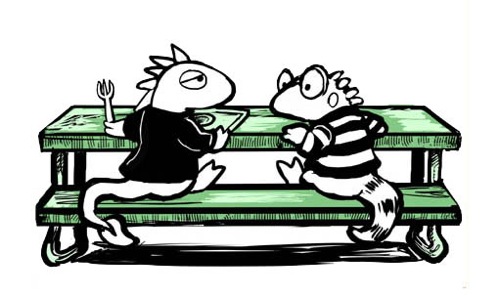
Ursula Vernon's Dragonbreath
It’s our favorite day of the year! The day retailer Brian Hibbs posts the complete Bookscan chart for the previous year, with his own analysis. You can download the entire chart for your own edification in the first link above, but we’ll just cut to the chase here’s the top 20 GNs for the year:
| 157,786 | DORK DIARIES | RUSSELL RACHEL RENEE | |||||||||
| 84,045 | BIG NATE FROM THE TOP | PEIRCE LINCOLN | |||||||||
| 39,382 | ADV OF OOK & GLUK KUNG FU CAVE | PILKEY DAV | |||||||||
| 36,436 | MAUS I | SPIEGELMAN ART | |||||||||
| 35,365 | WALKING DEAD COMPENDIUM 1 | KIRKMAN ROBERT | |||||||||
| 34,297 | TWILIGHT GRAPHIC NOVEL V 2 | MEYER STEPHENIE | |||||||||
| 32,931 | BONE OUT FROM BONEVILLE | SMITH JEFF | |||||||||
| 32,223 | PERSEPOLIS 1 | SATRAPI MARJANE | |||||||||
| 31,526 | NARUTO V 50 | KISHIMOTO MASASHI | |||||||||
| 30,885 | SCOTT PILGRIM V 1 SCOTT PILGRI | O’MALLEY BRYAN LEE | |||||||||
| 29,430 | ADV OF OOK & GLUK KUNG FU CAVE | PILKEY DAV
15 Comments on Bookscan: Kids comics ruled in 2011 bookstore sales, last added: 2/11/2012
Display Comments
Add a Comment
Blog: PW -The Beat (Login to Add to MyJacketFlap) JacketFlap tags: Sales, Sales Charts, Charts, Add a tag
Image was once again #3, with Dark Horse and IDW very close for fourth and fifth. Dynamite held on to its 6th place spot. Month-to-month sales were down, but year to year, they were up—in the case of periodicals WAY up: 32%. GNs were up by 18%. Year-to-year overall unit sales were up nearly 30%. The little heralded Bruce Jones/Sam Kieth original Batman GN BATMAN: THROUGH THE LOOKING GLASS led the GN charts. Two Robert Kirkman books, INVINCIBLE #15 and THE WALKING DEAD #1, were next.
TOP COMIC BOOK PUBLISHERS
|



![DC tops units; Marvel, dollars in January [update] Batman Through the Looking Glass DC tops units; Marvel, dollars in January [update]](http://www.comicsbeat.com/wp-content/uploads/2012/02/Batman-Through-the-Looking-Glass.jpg)
![DC tops units; Marvel, dollars in January [update] dollar share DC tops units; Marvel, dollars in January [update]](http://www.comicsbeat.com/wp-content/uploads/2012/02/dollar-share.jpg)
![DC tops units; Marvel, dollars in January [update] unit share DC tops units; Marvel, dollars in January [update]](http://www.comicsbeat.com/wp-content/uploads/2012/02/unit-share.jpg)
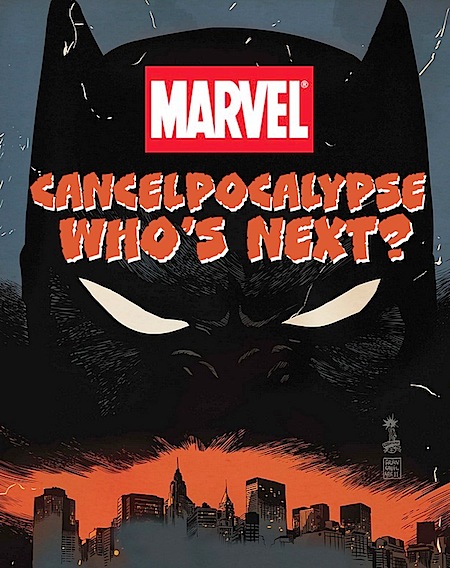

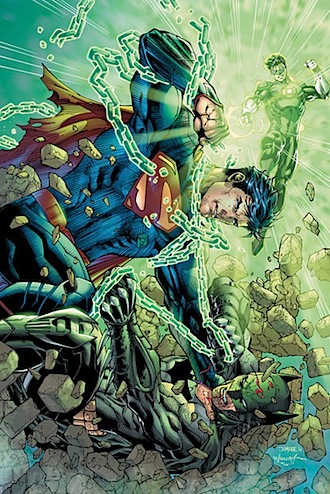 John Jackson Miller has posted his estimates for October 2011 sales ( ICv2’s will be out tomorrow) and it was
John Jackson Miller has posted his estimates for October 2011 sales ( ICv2’s will be out tomorrow) and it was 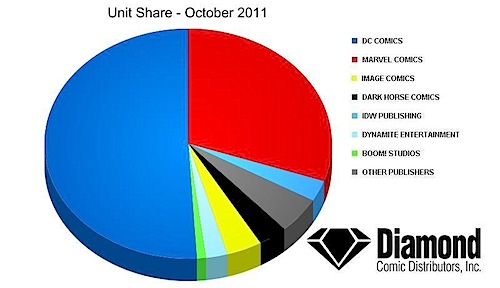
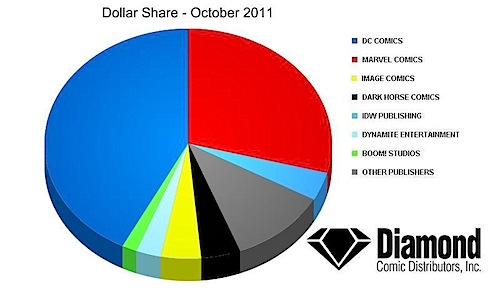


“The half full part? Kids read comics! Amazing. Something no one could have foreseen.”
That much concentrated sarcasm should require a doctor’s prescription.
Mike
It’s kinda amazing to me we can see this data every year, see the same thing every year (kids read comics), and yet most of the all ages stuff found in the DM is just awful. The real shame is there are creators making a real go of making good all ages comics, but they’re just lost in the white noise of junk.
I was *really* excited to buy Adventure Time #1 this past Wednesday and had to go to two comic stores in Brooklyn to find a copy! The first store didn’t know what I was talking about and the second store had to go behind the counter to produce a copy like it was porn. (The shame is buying that was easier than trying to find print copies of Snarked. I’m half convinced that book only exists on Comixology.)
But yeah…kids like reading comics but the comics industry on the whole seems to not care. I have high hopes this will be an area we’ll see improvement in. I think DM stores generally want to sell stuff their customers like, but it’s been challenging for them to find that stuff due to limited budgets and limited man-hours. I really hope with Marvel seemingly taking all ages books seriously we’ll see DM stores having a better shot of selling to that audience.
I think what is happening here, is some of these titles aren’t considered kid’s comics by the customers, but kid’s books.
Based on previous lists by Brian, I have ordered Dork Diaries, Big Nate, and Adv. of Ook and Gluk.
I have yet to sell any of them.
I’m on a busy downtown tourist street, and about 20% of my sales are books (other than graphic novels.) I do sell Bone on a constant basis, along with Calvin and Hobbes and Tintin and so on.
I sell the hell out of The Hunger Games, Hugo Caberet, etc.
But not to comic customers — to people off the street.
I doubt many comic shops are willingly forgoing the profits they might get from carrying Kid’s Comics.
But would getting Kid’s Books actually work for them? It would help if they were offered through Diamond, but again I suspect they see books like Dragonbreath as kid’s books not kid’s comics, and that isn’t their business.
I’m going to go to Baker and Taylor and immediately order Dragonsbreath an hope to catch a customer or two, but I’m already set up to do that.
Comics is comics. Kids don’t care if it’s a comic strip, a comic book, a collection of cartoon panels, or a graphic novel, or a picture book.
But kids reading comics? Well, 2012 marks the TENTH anniversary of the “Get Graphic” initiative at the American Library Association. Ten years of young adult librarians promoting graphic novels at libraries.
Now, the children’s librarians are beginning to notice. The mainstream publishers are selling to that market. DC? Marvel? Kinda sorta… via licensed properties and comics adapted with reading guides to match curricula.
I wonder what sort of picture develops if one takes the monthly Top 300 Graphic Novel lists published by ICV2?
“Comics are comics.”
Well, no.
Not when they’re considered kid’s books.
People go to bookstores for books.
They go to comic stores for comics.
Branding matters.
I personally agree that comics is comics.
I agree that that kids (not so sure about parents) buy whatever appeals to them, whether it’s called a comic or a book.
But the perception of what they’re buying, how people shop, really matters. I can carry books that people don’t expect me to have, but I can’t expect them to sell as well as the book they expect me to have — and vice versa.
Work in a comic shop sometime, and you’ll be amazed how blind the customers are to anything else you carry, no matter how prominently you display it or point it out.
The book are out of context. They shouldn’t be, but that’s the way they are perceived.
I say this as someone who actually carries a lot of children’s books.
I sell them to book buyers. I can sell Bone and Tintin to book buyers and comic buyers, but I can’t sell Nate to comic buyers.
Just asking a question here, but at a base sales level, does the comics/kids book distinction make that much a difference?
I understand that from an advertising perspective, it’d be tough to get parents in the area used to the idea that they’d rather seek out some of this material at a comic shop as opposed to a Barnes & Noble, but in terms of in-shop sales, if a comic store owner already has a targeted section for kids releases from the standard comics publishers that does well, wouldn’t racking highly popular comic-type projects from the big book publishers be a pretty easy sell?
If all I was carrying was comics and graphic novels, it think it would be a hard sell.
I carry a large selection of kid’s books and young adult, and I mix in as much graphic material as possible.
But I’m in a tourist zone and sell off the street pretty well.
The new survey from DC says that less than 2% of the buyers of the New 52 were under the age of 18.
You see the problem. At what point is a comic store beating a dead horse? You sell the clientele you got, not the clientele you wish you had.
I’m an exception because of the nature of my store, but even I wonder if it isn’t more a R % D effort, or good will.
Fortunately, I can sell Tintin and Archie and Asterix and Calvin and Hobbes, so I try hard to mix in all the rest.
For comics, oddly, they (parents) really want COMICS like they remember them to be, not as they currently exist.
DC and Marvel both have young readers versions of their super-heroes, but they don’t seem to like those either.
I don’t have the answers.
But I get a little tired of people saying that comics shops aren’t doing the job right when they don’t carry a huge section of kid’s comics. Most comic shop owners would love to sell more kid’s comics.
When you ask kids if they “like” comics the answer is almost universally yes. If you observe them going through the store, the answer is — but not enough to buy it. If the parents don’t buy, the kids usually won’t.
There is among parents, who are the real buyers, a real difference between “Kids” books and “comics”, even if you and I would find it hard to point out the differences.
What I’m saying is that there may not be an inherent difference between a well-illustrated kids books, or a wordy comic book, but there is a perceptual difference.
And that difference does matter when it comes to how much and to who they sell.
I think there are even visual clues — maybe not intentionally, but they’re there. Just like you take but a second to glance at the cover of a book and tell if it’s romance, S.F. or mystery.
Book publishers package differently enough that parents can immediately distinguish.
Call something a kid’s book, and they may buy. Call it a comic, and they may not.
It ain’t rational.
@Duncan
I apologize if my comment came out as anti-retailer. I think the fault here lies at the comic companies that have been filling the market with bad kids comics.
I think you and all DM retailers are at a disadvantage with kids comics/books. I think so much awful product has been given to you guys to sell as all ages comics that the perception has become comic stores are only good for grown up comics.
I think you guys are doing the best you can with what you’ve got. I think you guys need better stuff to sell. I mean, Adventure Time and Snarked are awesome, but you guys can’t base a retailing strategy around 2 books.
I don’t think it was the fault of the stores I’ve gone to I’ve had a hard time finding Kaboom titles. I wouldn’t invest much time/money/effort in selling kids books either with the amount of junk out there.
The more I look at the list the starker the separation between the markets becomes. THE ARRIVAL sold a ton of copies last year—I mean granted it is a visual masterpiece, but not really considered something comics shops would sell.
Personally, I wish we could get rid of the distinction between good kid’s books and comic books. I don’t see much difference, myself.
But I think we in the comic biz sometimes forget that there is still a huge bias against comics.
We’ve made enormous progress, but we’re only a little the way there. Like I said, I can sell books to people off the street, but I have hard time selling comics except to people who are already inclined to buy comics.
It’s 50/50 in my store, with not a whole lot of crossover.
Parents will buy Bone if I call it a young adult book and turn up their nose if I call it a comic.
I’m not saying it makes any sense. Sometimes a title will become what I call “culturally approved” and thus escape the everyday stigma of “comics,” but they are the exception, not the rule.
I’m a comic shop, but I sold more book copies of Twilight, than I did graphic novel versions of Twilight. I still have 15 out of the 20 copies I ordered.
Yet, apparently the graphic novels of Twilight sold in bookstores.
Explain that one to me.
At least adults are somewhat open to graphic novels like Walking Dead and Watchmen and Maus — like I said, “culturally approved.”
I can sell Asterix or Tintin to any parent who already knows what they are; I can’t sell Asterix and Tintin to any parent who doesn’t. Same books.
The ground has to be prepared, culturally, or it usually doesn’t happen. A “cold” sell is hard to make. Believe me, I try.
As in past years, I have used Brian’s data to it to inform my piece on the size of the overall market, fusing much of the known data:
http://blog.comichron.com/2012/02/big-picture-bookscan-comics-shops-and.html
Comics are 45% of the overall market, trades 55%. But the Direct Market is still 60% of the overall market, and nearly twice the size of the bookstore area.
IMHO there are PLENTY of good kids comics current and classics (the later not mentioned in this excellent discussion) available for retailers to stock and sell. i’m sure it ain’t always easy but a big pat on the back to the retailers who are giving it their best. it’s a big key to the future to figure the kid component out. the future of comics, the future of the shops. cartoonists, publishers, and retailers need to give the highest priority.
@ Torsten, Libraries are all well and good, but its not going to carry the industry.
Anyhow, How is Maus a kids book??? we know the demand is there, jus the content needs to be up to snuff for kids and appeal to them. one of us saying a kids book is good does not represent what kids actually think/want or even need, im not doubting that Adventure Time comic is good, but why cant we have kids clamoring over Mouse Guard or Anya’s Ghost like they do for Hunger Games or Hugo?